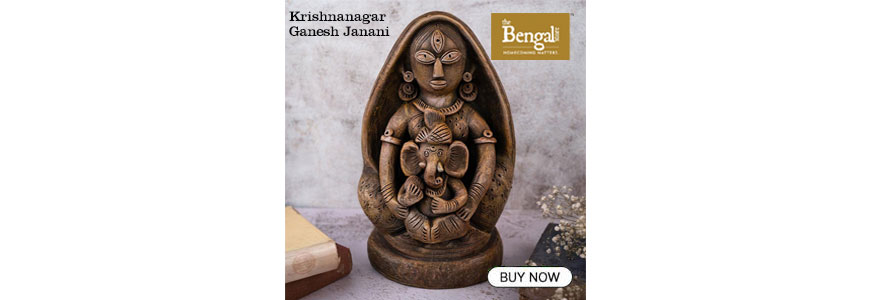Indraneel Bandopadhyay tries to keep the tradition of Lathi Khela alive in Bengal
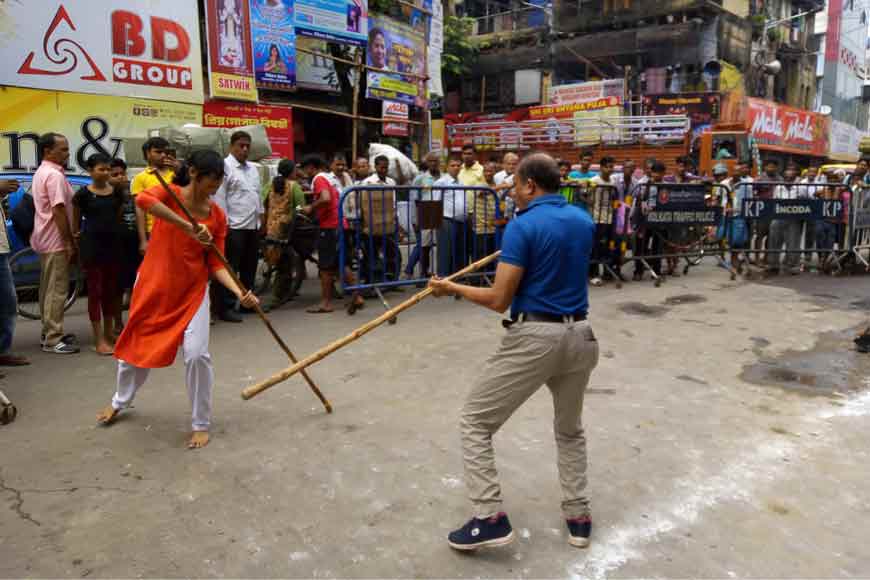
Lathi is an ancient Indian armed combat technique. It also refers to one of the world's earliest martial arts weapons. Lathi khela is an indigenous martial arts form of Bengal and its practitioners and experts are termed lathiyals. The very mention of ‘Lathiyal’ immediately brings to mind Pramatha Nath Chowdhury’s famous story, Mantra Shakti, that focuses on a poor middle-aged boatman named Ishwar Patni and his supernatural skills as lathiyal. He is not a professional ‘lathiyal’ yet people assume he is possessed by some spirit once he holds a lathi in his hand. The local landlord coaxes him to display his prowess during a friendly exhibition match of lathiyals hosted to entertain the landlord and his guests. Patni initially declines but later takes up the ‘lathi’ after seeking permission from lethel Moniruddin Sarkar and his team who had forced him to promise that he would never ever touch a lathi. What follows is a spectacular display, almost other-worldly show mesmerizing the audience. Later when the landlord asks him the secret of his power, he humbly says, “Hujur… Bidye hochchhe ashol shokti (Sir, knowledge is actual power).” It was ‘mantra-shakti’ or ‘Daiba shakti’ (God-gifted power), deduces the author, that gave Patni the edge over other lethels.
There was a time when the lathiyals of Bengal inspired terror among the British, because the best of them could wield their sticks with such speed and ferocity that the man behind the lathi often became a blur. It is a pity that we are responsible for chiming the death knell of this majestic indigenous game of Bengal. Recently, Get Bengal (GB) had an informal conversation with Mr Indraneel Bandopadhyay (IB), an enthusiast who is working diligently to sensitize people to preserve our indigenous culture, including music, dance and other art forms as well as the glorious tradition of ‘lathi khela’. An excerpt from the tête-à-tête:
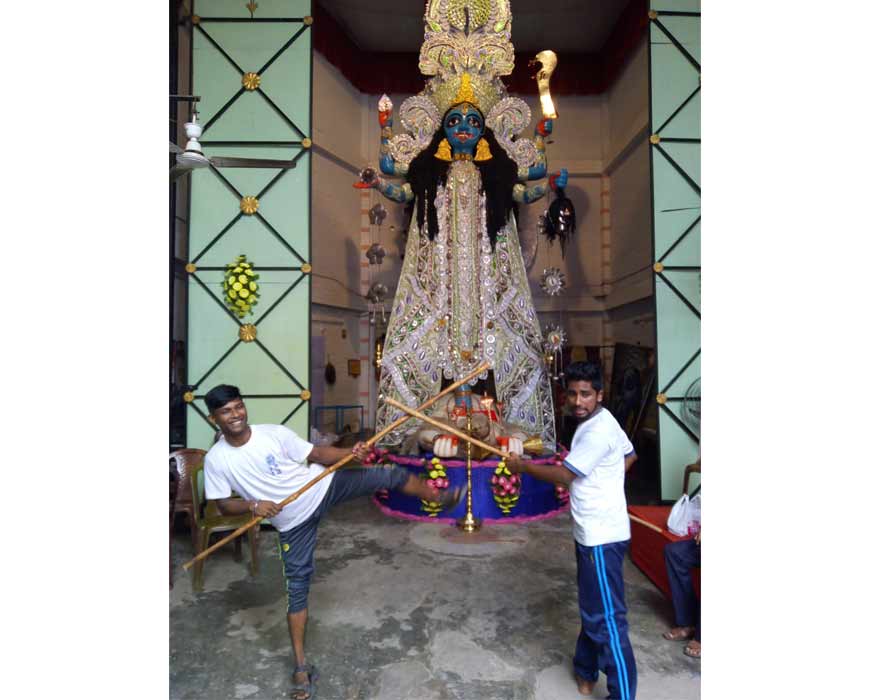
• Please tell us about the historical perspective of ‘Lathiyals’. How did they emerge as a class?
‘Lathiyal’ was a distinct social group in the rural society of Bengal during pre-British and British periods. A lathial then lived by wielding a specially designed bamboo stick called lathi. A lathi was a bludgeon, normally made of male bamboo, and sometimes bound at short intervals with iron rings, forming a formidable weapon. Every zamindar and taluqdar maintained an army of lathiyals or club-men headed hierarchically by jamadars, mrdhas and sardars. Like generals in wars, the jamadars and mrdhas were more strategists and instructors than fighters themselves. As highly skilled and courageous lathiyals, they worked as security guards to zamindars and guarded ‘kachhari bari’ (landlord’s office). Gomostas carrying money to treasuries were escorted by lathiyals.
• Stories of ‘lethel’ and ‘thyangare’ perpetrating cruelty on poor subjects galore. Are they true?
Yes. During the early British rule, when the colonial state was yet to penetrate into the countryside and government patronised zamindars, lathiyals were the official law keepers. Lathiyals were frequently summoned for muscle flexing during settlements of disputes between landlords and punishing the recalcitrant raiyats. It was customary on the part of landholders and other leading landed interests to settle dispute by ‘salishi’ (mediating). Lathiyals were sent only when settlement discussions failed. Going to court for redress was normally the last resort. Like landlords, indigo planters also maintained lathiyals to coerce with the unwilling raiyats. Lathiyals were highly mobile and were prepared to go on hire to any part of Bengal.
• How were the lathiyals hired?
There was a clear distinction between lathiyal and a barkanduz. A barkanduz was an officially designated lathiyal of the local authorities whereas lathiyal was like a private soldier who sold his skill to landholders and others in exchange of remunerations in cash or kind. In exchange of their services, jamadars and mrdhas were usually remunerated chakran or service tenure. Landholders, however, additionally maintained ordinary non-paid lathials. It is very interesting to mention here that the lathials of Bakarganj and Faridpur were known for their extraordinary skills and their services came with a hefty price tag. Hence only the uber rich landlords hired these men.
• From when did the importance of professional lathiyals decrease in Bengal?
The use of lathiyals for settling disputes began to wane from the 1860s when the British police system was re-organized. Large districts were divided into sub-divisions for better governance. The chaukidari or village police system was introduced in the 1870s. Many former lathiyal sardars became village chaukidars. With the tightening of district administration and with the spread of education among the landholding classes, the lathiyal system eroded fast from the beginning of the 20th century.
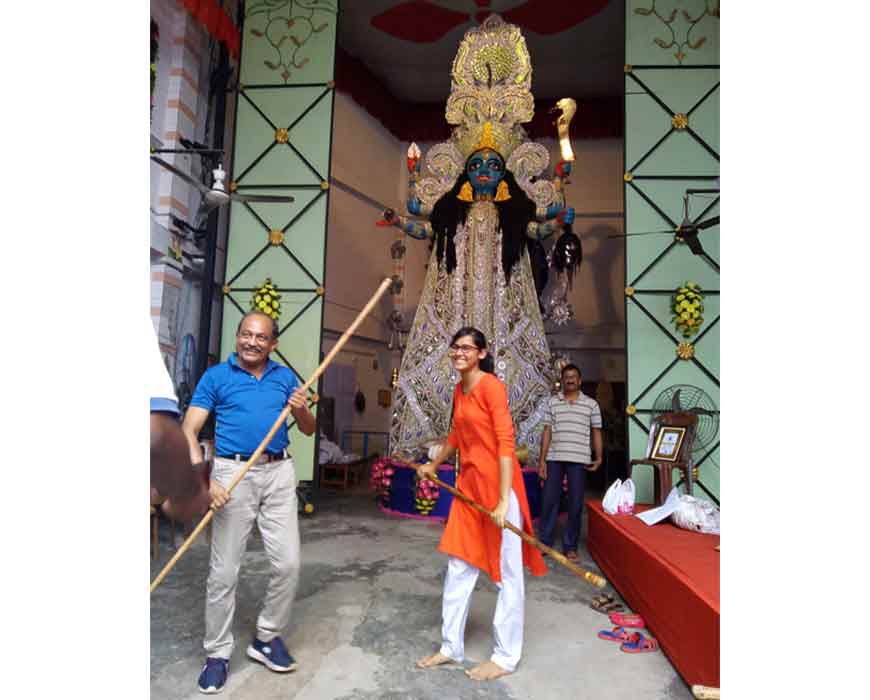
• But wasn’t lathi khela an integral part of revolutionary groups like Anushilan Samity, which became active from the beginning of the 20th century?
Yes, you are absolutely right. In the wake of the Swadeshi Movement in the first decade of the 20th century, revolutionary nationalism emerged as a potent political force in Bengal. Anushilan Samiti was one of the secret revolutionary organizations operating in Bengal in the first quarter of the 20th century. Anushilan Samity was established in 1902 by Satish Chandra Basu. This samity took initiative in forming many underground societies in different parts of Kolkata. In fact, the genesis of the terrorist parties in Bengal during this period can be traced to the formation of small, non-terrorist youth clubs devoted to the three-fold aims of physical, mental, and moral development of the youth. Such a concept, developed by Bankimchandra Chattopadhyay, Swami Vivekandanda, and Aurobindo Ghosh, is rooted in Shakta Hinduism. They urged the Hindus to become vigorous spiritually, physically and intellectually. To give effect to their thoughts, numerous youth clubs designated as Anushilan Samitis (Anushilan Samiti) were formed in rural and urban areas.
• How did lathi get sanction as a form of armed combat against guns and pistols?
Do not underestimate the power of lathi in the hands of an expert. Like Ishwar Patni, there were a large number of expert lathiyals who possessed the ability to instill fear in the minds of the British. When Pramathanath Mitra founded the Anushilan Samiti in 1902, he laid special emphasis on lathi khela and considered sticks to be the national heritage of Bengal. Aurobindo Ghosh also emphasized the importance of lathi khela. Brahmabandhab Upadhyay in his journal, Sandha Patrika, defined lathi as a tool of nationalist power. Bupendranath Dutta (Swami Vivekananda’s younger sibling) wrote an article titled ‘Latthyawshodhi’ (the stick as medicine) in Jugantar, a newspaper published by revolutionaries. In the essay he wrote, the lathi or stick was the only medicine required to drive away the British.
The name of Pulin Behari Das comes foremost when we discuss about introducing lathi as a martial art form in Bengal. Congress leader Bipin Chandra Pal's fiery speech against the Partition of Bengal at Dhaka in 1905 deeply stirred the listeners and spread unrest among Hindu gentry of East Bengal. Pulin Bihari Das, who was once a teacher in the Dhaka Government College and, later, a founding headmaster of 'National School' (Dhaka), formed Anushilan Samiti in Dhaka in September 1906. He underwent vigorous training from renowned ‘lathiyal’ of the time, Murtaza and then began training youngsters to use lathis and wooden swords for attacking opponents and also as weapons of self defense. In 1928, Das founded the Bangiya Byayam Samity, effectively an akhada where he began to train young men in stick play, swordplay and wrestling.
• Many believe that with the abolition of zamindari system in 1951, the lathiyals as a class were rendered unemployed and faded gradually and with their disappearance, lathi khela as a folk game also declined.
Whoever says that is actually misleading. If you want me to put it straight, I will say, we Bengalis are solely responsible for pushing our rich heritage to its throes of death by sheer apathy and total negligence. We fail to respect and preserve our rich and varied legacy. You see, if lathi khela is passé, then how come tourists, even foreigners, rave about similar stick games like Kalarippayattu of Kerala, Silambamis of Tamil Nadu, Gatkais martial art of Punjab and ancient Manipuri martial art form Thang-Ta? These art forms are not only popular and thriving in the respective states where they originated but are also attracting tourists to their states and bringing in the moolah. And look at us. We are sending our children to learn judo, karate, kung-fu, taekwondo etc but never bothering to inform them about our own martial art form or taking the initiative to introduce them to our indigenous lathi khela.
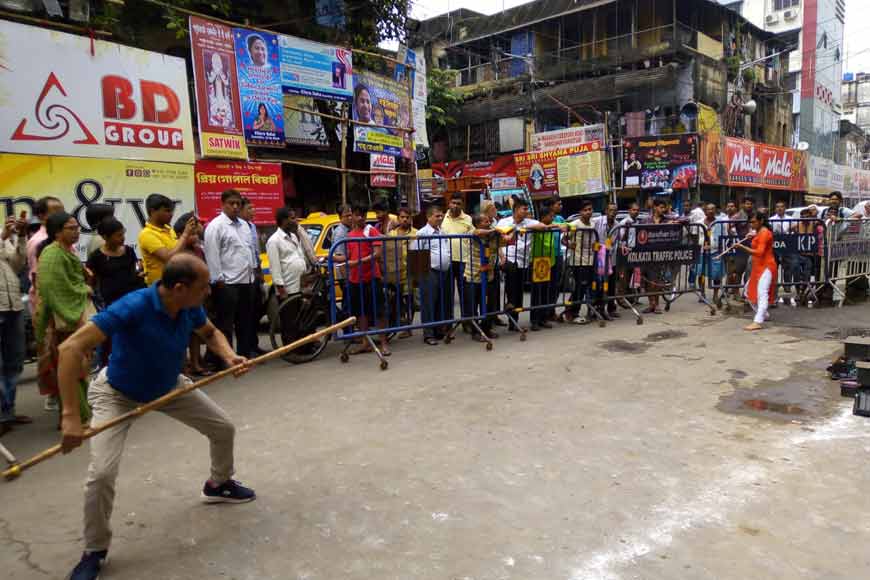
• Is there any way to reverse this trend and revive lathi khela and uplift it to its glorious past? Are you doing anything to revive this dying art form?
Earlier lathiyals contributed to the cultural arena in the form of mock fights between parties. They were invited to perform at social festivals including punya in the zamindari kacharis. I live in Pathuriaghata, one of the oldest localities in the city, and its origins can be traced to when the East India Company first started building Fort William in the late 1680s. Pathuriaghata Bayam Samity (PBS) was founded in 1908 by Bagha Jatin (aka ‘Tiger Jatin’ born Jatindranath Mukherjee, was an Indian independence activist. He was the principal leader of Jugantar party) and Atul Krishna Ghosh, a renowned lathi player and freedom fighter. Pathuriaghata Bayam Samity was a branch of Anushilan Samity. In 1910 all branches of Anushilan Samity were banned by the British government following the Muraripukur bomb case. Pathuriaghata Bayam Samity was re-opened in 1924 and as before, emphasis was given on providing rigorous physical training to youths which also included imparting training in lathi khela. Atul Krishna Ghosh, the founder of the club, died in 1927 during the annual Kali Puja festival. The members of the samity decided to organize Kali Puja from the very next year in memory of Ghosh and also as a front to organize armed revolutionary activities to fight against the British colonials. Thus Pathuriaghata Sarbojanin Kali Puja started in 1928. In 1930, Netaji Subhash Chandra was elected President of the puja committee. Lathi khela is an integral part of our annual Kali Puja celebrations. There are many youngsters who are willing to try out this martial art form but the onus is on us to encourage them, train them and organize regular shows to popularize this wonderful and aesthetically pleasing art form of Bengal. Lathi khela can also be introduced in schools where children can learn the intricacies of the game under trained lathiyals.
• But is it not strange that a popular martial art form like lathi khela has disappeared or is on the verge of extinction now?
We are trying our best to sensitize the urban population. Lathi khela is still practiced in pockets of many villages. We cannot deny that urbanization and the influx of television, cinema and Internet has led to the decline of rural martial art in recent decades but not all is lost yet. In North Bengal, for instance, a similar stick game called Chadi is played during Eid. In the southern part of West Bengal, "lathi khela" events are organized during various religious ceremonies, including Durga Puja. Lathi Khela organized at the annual ‘Beerashtami’ festival held at Baghbazar Sarbajonin Durgotsav premises on Ashtami morning is a very popular even and draws spectators from different parts of the country and even abroad. Lathi Khela organized by Pathuriaghata Sarbojanin Kali Puja committee is also a much-awaited annual event that is attended by a formidable crowd. We need to organize more events to attract youngsters to this martial art form. It is inexpensive and strengthens both mind and body. I am a die-hard optimist and am hopeful that if we all come together to popularize lathi khela, we can revive the prestige of this once glorious martial art form.







